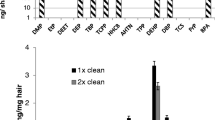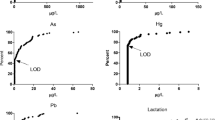Abstract
A simplified thiourea-based chromatography method, originally developed for methyl and inorganic mercury, was adapted to separate methylmercury (MeHg), ethylmercury (EtHg), and inorganic mercury (HgII) in infants' hair. Samples were weighed and leached with an acidic thiourea solution. Leachates were concentrated on a polymeric resin prior to analysis by Hg-thiourea liquid chromatography/cold vapor atomic fluorescence spectrometry. All but one sample showed small amounts of EtHg, and four of the six analyzed samples had proportionally higher HgII as a percent of total Hg. Breastfed infants from riverine Amazonian communities are exposed to mercury in breast milk (from high levels of maternal sources that include both fish consumption and dental amalgam) and to EtHg in vaccines (from thimerosal). The method proved sensitive enough to detect and quantify acute EtHg exposure after shots of thimerosal-containing vaccines. Based on work with MeHg and HgII, estimated detection limits for this method are 0.050, 0.10, and 0.10 ng g−1 for MeHg, HgII, and EtHg, respectively, for a 20-mg sample. Specific limits depend on the amount of sample extracted and the amount of extract injected.




Similar content being viewed by others
References
Pichichero ME, Gentile A, Giglio N, Treanor J et al (2008) Mercury levels in newborns and infants after receipt of thimerosal-containing vaccines. Pediatrics 121:e208–e214
Westphal GA, Schnuch A, Schultz TG et al (2000) Homozygous gene deletions of the glutathione S-transferase M1 and T1 are associated with thimerosal sensitization. Int Arch Occup Environ Health 73:384–388
Barbosa AC, Boischio AA, East GA et al (1995) Mercury contamination in the Brazilian Amazon. Environmental and occupational aspects. Water Air Soil Pollut 80:109–121
Ohno H, Doi R, Kashima Y (2004) Wide use of merthiolate may cause mercury poisoning in Mexico. Bull Env Contam Toxicol 73:777–780
Gibicar D, Logar M, Horvat N et al (2007) Simultaneous determination of trace levels of ethylmercury and methylmercury in biological samples and vaccines using sodium tetra(n-propyl)borate as derivatizing agent. Anal Bioanal Chem 388:329–340
Marques RC, Dórea JG, Fonseca MF et al (2007) Hair mercury in breast-fed infants exposed to thimerosal-preserved vaccines. Eur J Ped 166:935–941
Qvarnstrom J, Lambertsson L, Havarinasab S et al (2003) Determination of methylmercury, ethylmercury and inorganic mercury in mouse tissues, following administration of thimerosal, by species-specific isotope dilution GC-inductively coupled plasma-MS. Anal Chem 75:4120–4124
Holmes J, Lean D (2006) Factors that influence methylmercury flux rates from wetland sediments. Sci Total Environ 368:306–319
Burbacher TM, Shen DD, Liberato N et al (2005) Comparison of blood and brain mercury levels in infant monkeys exposed to methylmercury or vaccines containing thimerosal. Environ Health Perspect 113:1015–1021
Zareba G, Cernichiari E, Hojo R et al (2007) Thimerosal distribution and metabolism in neonatal mice: comparison with methyl mercury. J Appl Toxicol 27:511–518
Shade CW, Hudson RJ (2005) Determination of MeHg in environmental sample matrices using Hg-thiourea complex ion chromatography with on-line cold vapor generation and atomic fluorescence spectrometric detection. Environ Sci Technol 39:4974–4982
Vermillion BV, Hudson RJM (2007) Thiourea catalysis of MeHg ligand exchange between natural dissolved organic matter and a thiol-functionalized resin: a novel method of matrix removal and MeHg preconcentration for ultratrace Hg speciation analysis in freshwaters. Anal Bioanal Chem 388:341–352
Shade CW (2008) Automated simultaneous analysis of monomethyl and mercuric Hg in biotic samples by Hg-thiourea complex liquid chromatography following acidic thiourea leaching. Environ Sci Technol 42:6604–6610
Magos L (2003) Neurotoxic character of thimerosal and the allometric extrapolation of adult clearance half-time to infants. J Appl Toxicol 23:263–269
Schnuch A, Uter W, Geier J et al (1998) Contact allergies in healthcare workers. Results from the IVDKA. Acta Derm Venerol 78:358–363
Dórea JG (2007) Exposure to mercury during the first six months via human milk and vaccines: modifying risk factors. Am J Perinat 24:387–400
Acknowledgements
We thank the National Research Council of Brasil-CNPq for the research grant (CT-HIDRO, project-555516/2006-7) that paid for the analytical work.
Author information
Authors and Affiliations
Corresponding author
Rights and permissions
About this article
Cite this article
Dórea, J.G., Wimer, W., Marques, R.C. et al. Automated Speciation of Mercury in the Hair of Breastfed Infants Exposed to Ethylmercury from Thimerosal-Containing Vaccines. Biol Trace Elem Res 140, 262–271 (2011). https://doi.org/10.1007/s12011-010-8695-0
Received:
Accepted:
Published:
Issue Date:
DOI: https://doi.org/10.1007/s12011-010-8695-0




